Railways in colonial Bengal
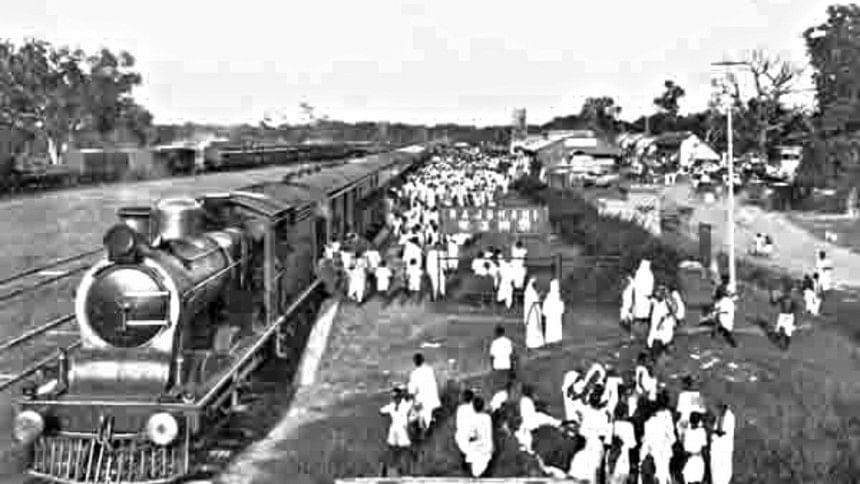
After conducting a year-long survey of landscape, possible routes and profitability, Macdonald Stephenson, a Scottish engineer, proposed the first Indian railway scheme in 1845. In his scheme of "triangulating India with railway" at a cost of about fifty million pounds, Stephenson presented an ambitious idea of setting up a vast railway network in order to connect Calcutta, Delhi, Bombay and Madras with other major towns in between. Regions east of Calcutta or eastern Bengal (later to become Bangladesh), along with Assam, were excluded from the purview.
The disadvantages of excluding eastern Bengal from the initial railway projects, however, were soon identified. A 15-page monograph, published in 1848 by a certain Transit, strongly criticised Stephenson's new East Indian Railway Company. In insisting that the trade of Bengal should be considered in the future expansion of the railways in India, Transit appeared to have been informed by a wider vision of the water regime of the lower Ganga Valley which provided the sole impetus for an extensive range of trade and commerce.
Transit compared the lower Ganga Valley to a funnel whose apex was the starting point of the Delta and he viewed Calcutta as a bottle which would draw the trade of the Ganga Valley through the funnel where the proposed railways would work like a pipe. According to Transit's scheme, therefore, the railways were supposed to have a complementary rather than confrontational relationship with the eastern Bengal Delta.
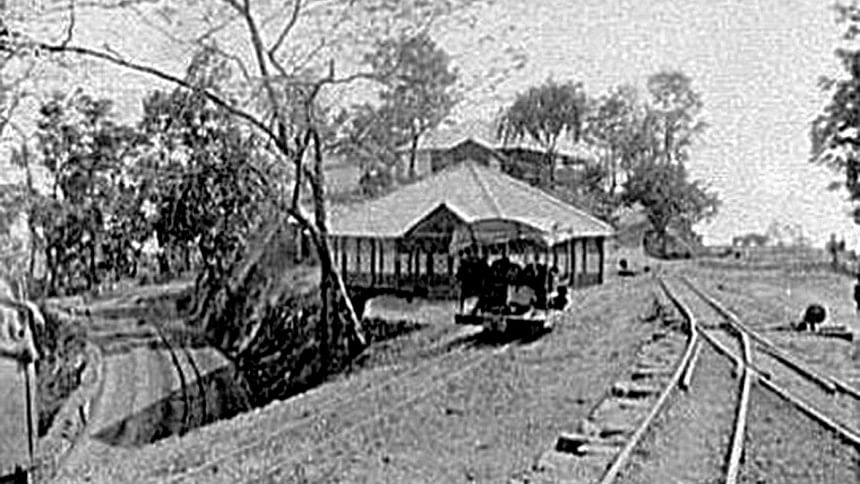
If the expansion of the railways in Bengal in the following decades were examined in relation to Transit's scheme, it would appear that the commercial importance of the Bengal Delta as pointed out by Transit was fully taken into consideration; but there was a fundamental difference between his scheme and the railway projects that were actually carried out. Unlike Transit's scheme, these railways engaged with the Ganga Delta through its fluvial heart and in consequence they began to contest rather than complement the water regimes of the Delta.
With a view to eventually connecting Calcutta with Dhaka, the first railway line was opened from Calcutta to the lower Ganga bank in Kushtia in September 1862. In 1871, this line was extended southward to the Goalundo bank of the Ganga. With its many branches extending along both banks of the lower Ganga, it came to be known as the Eastern Bengal Railway (henceforth EBR). In July 1884 the government acquired the EBR and amalgamated it with the Northern Bengal State Railway in 1887. The first section of the Assam-Bengal Railway (henceforth ABR) was opened between Chittagong [now Chattogram] and Comilla [now Cumilla]in 1895. The line was constructed to meet the demand of the tea companies in Assam which wanted railway facilities for the export of tea via the Port of Chittagong. This line lay on the left bank of the Ganga and both banks of the Brahmaputra. In 1942, the ABR was taken over by the state and was amalgamated with the EBR to form the Bengal and Assam Railway. The expansion of the railways was such that by 1933 Bengal had more railways on the basis of area than any province except the United Provinces.
The root of the problem appears to lie not in the erection of the railway itself but in the fact that the government and different railway companies, while encouraging the construction of the railways, failed to appreciate the relative importance of inland waterways. In eastern Bengal, waterways were often seen as rivals to the railways as means of transport and there was a feeling that with the completion of the railway networks, the transport and communication systems would be faster and more reliable at the expense of the "slower" mode of water transports. By the beginning of the twentieth century, the patronage of and enthusiasm for the railways turned full circle. On the other hand, efforts to improve the waterways were relatively feeble as reflected in the fact that whereas total expenditure on the improvement of navigation facilities was in the area of 5,000,000 pound sterling during the last three decades of the nineteenth century, expenditure on the railways during the same period had exceeded 200,000,000 pound sterling.
Though conditions in Bengal were "more favourable for the improvement and extension of such navigation facilities than in any country in the world," the bias towards railways in eastern Bengal continued.
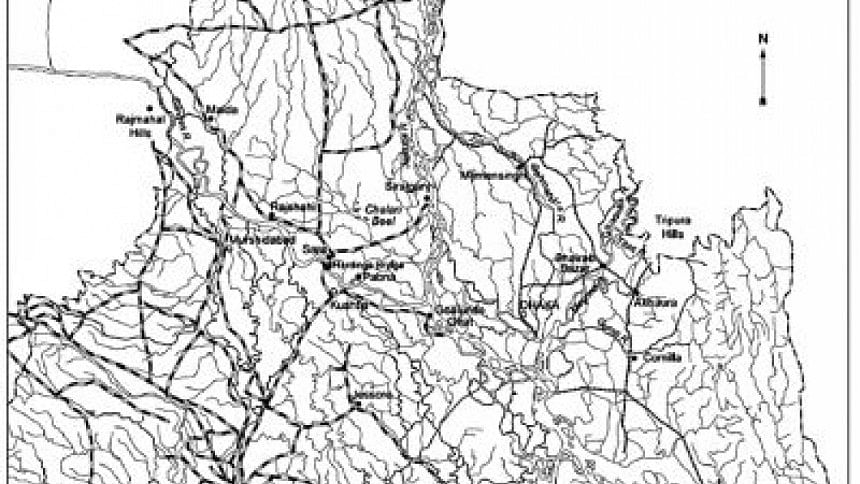
As engineering sophistication became secondary to investment portfolios and commercial schemes, and as the water regime of the Delta lay within the jurisdiction of the railway companies, the simple solution appeared to be massive extension of embankments on which the railways were to run. Practically all railways in Lower Bengal were built on embankments.
The impact of the railways on the water bodies and consequently on the agrarian economy of colonial Bengal could be examined through the case study of the Eastern Bengal Railways (EBR). The first railway line of eastern Bengal, running from Calcutta (Sealdah) to Goalundo, was constructed on the floodplain of the Ganga, which, along with its numerous branches and tributaries, flowed to the Bay of Bengal. Initially there were almost no outlets for the passing of water through the embankment on which this line was constructed. The necessity of outlets through the embankment was felt every time there was a flood. Eighty four, nine hundred and one thousand lineal feet of "opening" were added in 1868, 1871 and 1885 respectively. After the floods of 1890, a further four hundred feet were added.
The north-western segment of the EBR contributed to the deterioration of the water regime of Northern Bengal by the way the railway exposed itself to the Chalan Beel. The Chalan Beel was a vast deep hollow with a watershed of about 1,547 square miles, lying in the districts of Rajshahi and Pabna, where a very large portion of the drainage from about 47 rivers of Northern Bengal converged. Besides being a giant junction of numerous waterways, the beel also served as a springboard from which many rivers flowed further south and east to meet finally with Padma or Brahmaputra. With the waterways that converged in it from the north and north-west and with those that exited from it towards the east and south-east the Chalan Beel formed a water regime that reserved and cleared the drainage of almost half of the active Bengal Delta. By the beginning of the twentieth century the beel was surrounded by the EBR main line in the west and by the Santahar-Bogra line in the north. Since the beel filled from the north-west and south-west, the "feeding" was intersected by the Bogra [now Bogura]-Santahar Branch line and the EBR main line and since it drained in a south-easterly direction to the Brahmaputra, the drainage was intersected by the Sara-Sirajganj Branch line of the EBR. The natural drainage of the water regime in this part of the Delta met with formidable obstacles since railways in these low lands had to be built on embankments. Such a situation was further aggravated by the reduction of the number of spans on the bridges of the EBR since the broad gauge line was constructed between Atrai and Santahar. In this area the total existing outlets in the early 1920s were reported to be 440 feet as compared with 967 when the line was first constructed. In the case of the southern branches of the EBR, for instance, although the combined catchment area of the waterways was 1.5 square miles between the Dadshi and Pachuria railway stations in Khulna, there were only four openings. Although the government officials considered the openings 'adequate', the actual measurement of the four openings revealed that there were two pipe culverts each of 1.6 feet diameter and two girder bridges of 1x12=12.0 feet and 1x20=20.0 feet diameter for the entire catchment area. Such inadequate openings were found in almost every culvert or railway bridge in the Delta.
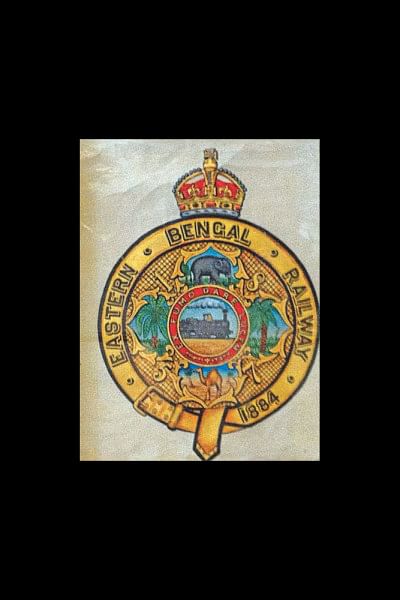
The main EBR line (Calcutta-Siliguri) ran across the Rajshahi plains, the natural slope of which was towards the east. Railway embankments interrupted the natural drainage of the country causing a blockage of a great volume of water, the effect of which was the complete destruction of aman (autumn) paddy, the only subsistence crop of the land, during rainy periods. The water took a long time to escape through the culverts and bridges which were very few in number. A part of the line also passed close to the Chalan Beel and thus prevented its flush water from draining to the Brahmaputra; the result of this interruption was the speedy silting up of the beel and the consequent reduction of its water-holding capacity. This reduction, according to a government official, was one of the factors underlying the frequent flooding following the construction of the Sara-Sirajganj Railway. The cultivators of the vast area to the north-west of the Sara-Sirajganj line had to forgo the cultivation of rabi (winter) crops as the fields did not dry up in time for cultivation.
The Bogra line up to Bogra ran almost directly east blocking the natural flow of water of a part of the country which sloped from north to south. This caused damage to the only crop (aman variety of rice) of the tract since the water could not drain. But as the flood water slowly moved further down either through an insufficient number of culverts and bridges or by over-topping or breaching the embankment, it was again obstructed by a part of the Sara-Sirajganj Railway embankment. The same degree of devastation of crops occurred in these tracts until the water finally found its way into the Brahmaputra.
It would perhaps be naïve to attribute agricultural decline in Bengal from the early twentieth century to the railways alone. But there are indications that the railway embankments, by contributing to the deterioration, drying up and death of various types of water bodies, may well have indirectly contributed to the overall agrarian decline in Bengal.
Historians have argued that one of the reasons for the Bengal Famine in 1943 was the stoppage of importation of rice from Burma during the Japanese occupation. But they have hardly enquired why, in the first instance, rice production declined in eastern Bengal. In this context, it might be assumed that the decline of the ecology led to a decline in both commercial and subsistence produce which, in combination with other factors, ultimately led to the famine. One needs to raise the question whether the railways with their long arms of embankments could partly be responsible.
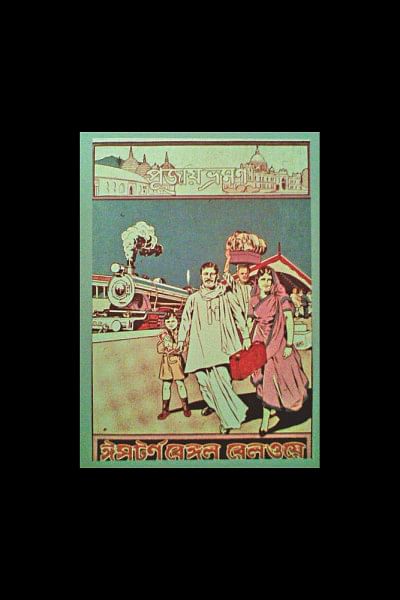
The railways in Bengal in particular and India in general expanded amidst overwhelming approval from investors in London and colonial officials and an emerging middle class in Calcutta. A positive perception of the railways was so wedded to the state-formation process that there was hardly any room for critical voices. An overt emphasis on the potential of the railway as a system and symbol of modernisation met with sharp reaction from those who were sceptical about modernity itself. Karl Marx hoped for an extensive irrigation system, emerging as a result of digging the soil for railway embankments, but he did not see the problem of drainage. On the other hand, Gandhi could well perceive the railways as carriers of fatal diseases like the plague, but he did not pay much attention to the capacity of the railways to create disease itself by destroying the environment.
Surprisingly, a scientific approach to the problem of embankment in the deltaic landscape of Bengal came from a segment of the colonial officialdom. In 1846, a committee appointed to examine the problem of embankments in Bengal put forward some strong arguments against any barrier in the fluvial and flat landscape. Comprised of two engineers and a botanist, the committee proposed a "return to that state of nature, which, in their opinion, ought never have been departed from." To achieve this goal, the committee recommended the total removal of all existing flood embankments to allow the free flow of water. The proposed system, to be built in consonance with "local experience", was tantamount to reversing the existing system of embankments by substituting them with drainage. But this possibility had soon to give way to a solution favouring the construction of railways on high embankments—a clear reflection of the enthusiasm for modern technology and the interests of powerful capitalists. "Science of tradition" was easily replaced by a "science of the steam engine". When CA Bentley, Director of Public Health, Bengal, reiterated his concern in the early twentieth century over the negative impact of the railway systems on the water regime of Bengal and on its ecology and agriculture, it was too late, for the railways had already become an integral part of public life.
In the light of the above discussions, it is hoped that Bangladesh policy-makers and investors make sure that the current development of infrastructure on the rivers of Bangladesh doesn't result in another spell of ecological and human disaster in the long run.
Dr Iftekhar Iqbal is Associate Professor and Programme Leader, History and International Studies Programme, Faculty of Arts and Social Sciences, Universiti Brunei Darussalam.
This article has been excerpted and modified for publication by the author from his paper "The Railways and the Water Regime of the Eastern Bengal Delta c1845-1943".





Comments